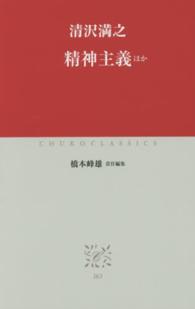- ホーム
- > 洋書
- > 英文書
- > Literary Criticism
Full Description
The Sheik-E. M. Hull's best-selling novel that became a wildly popular film starring Rudolph Valentino-kindled "sheik fever" across the Western world in the 1920s. A craze for all things romantically "Oriental" swept through fashion, film, and literature, spawning imitations and parodies without number. While that fervor has largely subsided, tales of passion between Western women and Arab men continue to enthrall readers of today's mass-market romance novels. In this groundbreaking cultural history, Hsu-Ming Teo traces the literary lineage of these desert romances and historical bodice rippers from the twelfth to the twenty-first century and explores the gendered cultural and political purposes that they have served at various historical moments.
Drawing on "high" literature, erotica, and popular romance fiction and films, Teo examines the changing meanings of Orientalist tropes such as crusades and conversion, abduction by Barbary pirates, sexual slavery, the fear of renegades, the Oriental despot and his harem, the figure of the powerful Western concubine, and fantasies of escape from the harem. She analyzes the impact of imperialism, decolonization, sexual liberation, feminism, and American involvement in the Middle East on women's Orientalist fiction. Teo suggests that the rise of female-authored romance novels dramatically transformed the nature of Orientalism because it feminized the discourse; made white women central as producers, consumers, and imagined actors; and revised, reversed, or collapsed the binaries inherent in traditional analyses of Orientalism.
Contents
Acknowledgments
Introduction
Chapter 1. Loving the Orient: The Romantic East and European Literature
Chapter 2. The Rise of the Desert Romance Novel
Chapter 3. E. M. Hull's The Sheik
Chapter 4. The Spectacular East: Romantic Orientalism in America
Chapter 5. The Orientalist Historical Romance Novel
Chapter 6. The Contemporary Sheik Romance Novel: The Historical Background
Chapter 7. Harems, Houris, Heroines, and Heroes
Chapter 8. From Tourism to Terrorism
Chapter 9. Reader Responses to the Modern Orientalist Romance Novel
Conclusion
Notes
Bibliography
Index








